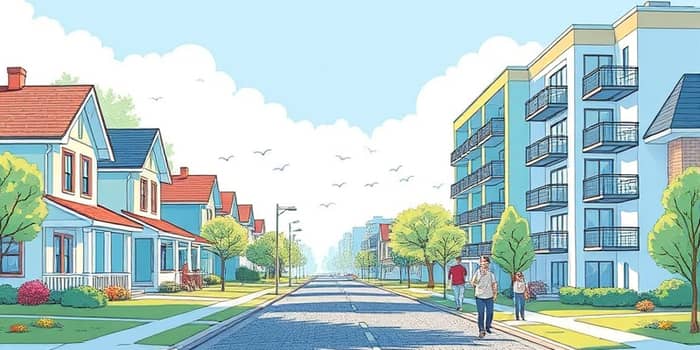
As we move deeper into 2025, the U.S. housing market has entered a period of modest adjustments and emerging opportunities. After years of rapid price acceleration, persistently high mortgage rates and slowed construction have combined to moderate home value growth to just over 2%, with some forecasts even predicting a decline. At the same time, a growing renter population is reshaping demand, driven by affordability challenges and evolving lifestyle preferences. This article explores the nuances of this shifting landscape, offering practical strategies for renters, landlords, and investors navigating change.
While national home values now average around $367,969—up just 0.8% over the past year—inventory is rising, approaching normalization in some metropolitan areas. Yet supply remains below historical norms in many regions, reflecting a market that is simultaneously thawing and still constrained. For those seeking stable ground, understanding the forces at play can reveal a renewed sense of possibility in both ownership and rental sectors.
In early 2025, home price growth has cooled dramatically from peaks of 4.5% in 2024 to an expected 2–3% this year, according to multiple housing analytics firms. Some models, including Zillow’s, even predict a -1.7% drop between March 2025 and March 2026. Meanwhile, the total inventory of homes for sale has climbed by 30.6% year-over-year as of April, marking eighteen consecutive months of growth. Sellers listed more than 375,000 properties in March alone, up 9% from the prior year.
New construction has also contributed to the shift: with 481,000 new homes for sale, we are at the highest supply since 2007. Speculative builds stand at 385,000, the highest since 2008. Despite these gains, a fully balanced market remains elusive, as single-family existing homes for sale still trail previous trough levels by 20–30%.
Several key factors underlie this moderation. First, ever-rising home prices during the pandemic pushed many buyers to the sidelines, awaiting a more affordable window. Second, mortgage rates have stubbornly hovered around 6.5%, significantly above the sub-4% levels seen in 2020–2021. This higher borrowing costs for buyers environment directly impacts borrower purchasing power and increases monthly carrying costs.
Third, economic uncertainties—including international tariffs, fluctuating inflation, and new federal policies—have heightened caution among would-be sellers and buyers. This hesitancy is reflected in shorter listing windows and more conservative pricing strategies. Even as more homes hit the market, many remain priced at the top end, limiting availability for first-time buyers and pushing costs well above median incomes.
As purchasing becomes more challenging, renting has grown in appeal. The number of renter-occupied single-family homes rose 18% between 2016 and 2024, a trend expected to continue. Forecasts project an additional 0.9 million renter households by 2029, reflecting a growing renter population seeking flexibility and affordability.
Hybrid and remote work models have further reinforced this shift. Many tenants now prioritize properties with dedicated home offices, reliable connectivity, and communal spaces. With homeownership costs averaging 40% more than renting, renters value amenities over equity, and stability over speculation.
Rental price growth has stabilized accordingly. Zillow projects rental rates will rise by roughly 3% nationwide in 2025, down from an annual average of 7% during the pandemic. This stable and predictable rent growth benefits both tenants, who can plan budgets more confidently, and landlords, who face lower vacancy turnover and more reliable cash flow.
In this evolving market, each stakeholder can adopt tailored strategies to thrive. Renters can leverage their position by recognizing that landlords may be more open to negotiation, especially in areas with higher vacancy risks. Armed with tools to negotiate fair lease terms, tenants can secure favorable rent concessions or improved maintenance agreements.
Landlords and property managers benefit from focusing on tenant retention. Upgrading energy-efficient appliances, offering flexible lease lengths, or creating shared workspaces can distinguish a property in a crowded market. By delivering value and responsiveness, owners transform apartments into communities—encouraging longer stays and reducing turnover costs.
Investors looking to enter or expand in residential real estate should consider diversifying across property types. Single-family rentals remain attractive in suburban markets, while multifamily complexes offer economies of scale in metro cores. Strategic adjustments in pricing and amenities allow investors to maintain occupancy and optimize revenue, even as broader economic currents shift.
Looking forward, the U.S. housing market will likely remain in a state of cautious adjustment. For homebuyers, longer-term rental commitments and stability may be the bridge to future ownership. Saving for down payments and monitoring interest rate trends can position buyers to act swiftly when rates ease.
Landlords should prepare for a potential rent surge after 2026, when new apartment completions slow. Maintaining a pipeline of property enhancements and cultivating positive tenant relationships now lays the groundwork for premium pricing later. Investors can safeguard returns by diversify their investment portfolios across geographies and asset classes, balancing risk with opportunity.
The evolving market also presents a chance to advocate for affordable housing solutions and community initiatives. Public-private partnerships, inclusionary zoning, and support for first-time buyer programs can help close the affordability gap. By engaging with local policymakers and housing organizations, stakeholders contribute to a more inclusive and resilient housing ecosystem.
Ultimately, this period of a dynamic housing landscape invites all participants to adapt, collaborate, and innovate. Whether renting or owning, managing properties or building portfolios, embracing flexibility and insight can unlock hidden value. As the dust settles on a cooled market, a a renewed sense of possibility emerges—one where careful planning, community focus, and strategic action lead to lasting success.
References













